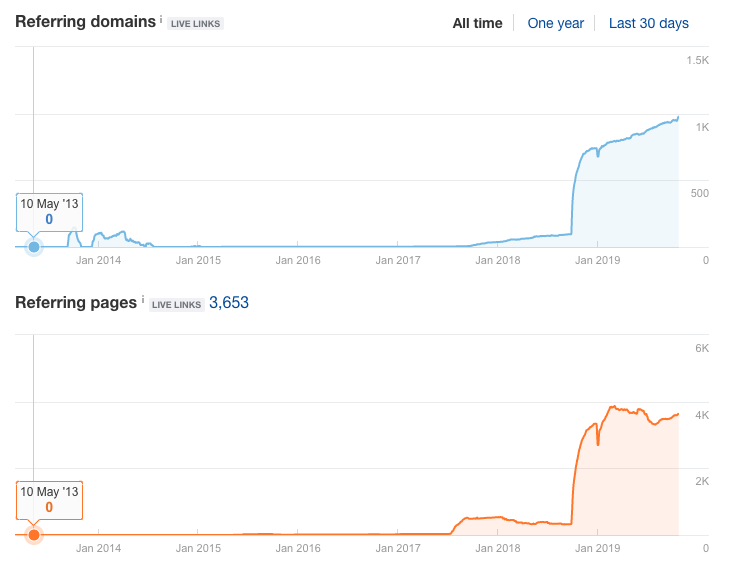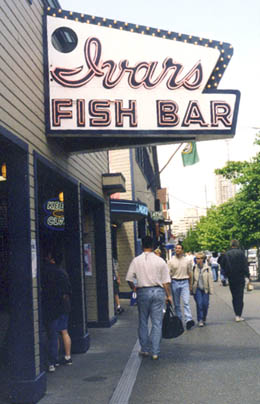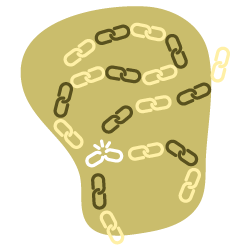If you have a website then, there’s a good chance that your site contains links – these can be paid or acquired links including adverts, articles and directories as well as comments on forums and social media. A quick glance on any techy site will show you that links – building them and maintaining them is one of the most important – and most talked about topics for businesses in today’s world.
Why are links such a big deal?
For a business, links are incredibly important as they affect the way in which Google ranks your web pages – something which can make or break a business. Google suggests that a business wishing to improve its ranking, should increase the number of high quality sites which link to its site. Essentially, the more high quality links that you have, the more trustworthy your site is in the eyes of the Gods of Google – and more trust means better ranking.
Degrees of separation
First, it’s important to look at technical SEO – also known as on-page SEO in comparison to off-page SEO. As we know, SEO (search engine optimisation) is all about getting your page noticed. On page SEO is all about your own page or website – within this, you can play around with your keywords and phrases and optimise tittes and meta tags to make it as visible as possible. Off page SEO, on the other hand, is the art of spreading the net wider and is also known as link building. With off page SEO, the idea is to get an article or blog published on an external (somebody else’s site) with a link to your site. This means that readers looking at other websites are then directed to yours. For this reason, it’s really important to work hard to gain high quality links to your page or site.
What are high quality links?
In 2019, the site that you are linking to should be authoritative and contain relevant content in order to be considered ‘high quality’. This means that it’s no good to just chuck as many links onto your site as possible as Google will see through this tactic. Business, therefore, need to work on their own reputation and visibility in order to forge connections with sites providing these high quality links.
Following so far?
Good – so, now, we’ll take a look at two of the most important kinds of link; No Follow and Do Follow.
No Follow: These are links with a rel=”nofollow” HTML tag attached to them. The nofollow tag tells search engines to ignore the link due to the fact that nofollow links do not pass page rank and therefore, don’t impact search engine rankings
Do Follow: These links allow Google (and other search engines) to follow them in order to reach your website – this then gives you a backlink. If a webmaster is linking back to you with this link then, both Search Engine and Humans will be able to follow you.
As you can imagine, Do Follow links are the holy grail of link building for many businesses.
Trust Flow / Domain Authority
These slightly baffling terms are ones you’ll come across a lot – so you’d better get used to them. The following is the lowdown on these:
Domain Authority – Created by Moz, Domain Authority uses data to rank a site from 1 to 100 using a logarithmic process. To do this, it considers a number of factors including:
- Number of external links to the site
- Number of internal links
- Trustworthiness (or quality) of links
- Popularity of link sites
- Relevancy of link sites
- Anchor text used (see our A to Z glossary for this one)
Trust Flow – Created by Majestic, Trust Flow assigns a score to an URL or domain based on the quality of its external links – in short, Trust Flow measures the trustworthiness of your site by the trustworthiness of the sites that it links to.
Truth and lies
Whilst we’re on the subject of trust – as we’ve mentioned, the internet is crammed full of information about link building – unfortunately, not all of it is accurate. We take a look at some of the common myths surrounding this complex subject:
Build it and your work is done
There are those who will tell you that all you need to do is to create great content and customers will automatically flock to your site. Sadly, this is very much not the case unless your business is established and well known. You’ll need to work hard at gaining your links – and may well have to pay for them initially.
You can score great ranking without links
Of course links are not the only factor that Google uses to rank your pages but they really do matter. Building a solid network of high quality links is the only way to gain traction when it comes to Google ranking.
Your links need to go straight to the money
Many so-called experts will tell you that all of your links have to go directly to your money pages (the ones where the sales are made). In reality, this often is perceived as spammy and too salesy and should be avoided. Instead, direct links to great content or resource pages.
Link building is only for Google ranking
We’ll press that buzzer again – this is also completely incorrect. Although link building is essential for scaling the heights of Google ranking, it’s also great for building relationships. By its very nature, link building leads to connection with influencers and authority figures within your industry and, building and maintaining a network through these connections will always be great for your business.
You need to be techy for link building
OK, we’ll admit that you need to know your way around your computer (and your website) in order to successfully build links but, you certainly don’t need any specialist skills such as coding or web development.
All follow links are equal
Like so much in life, there is a definitely inequality when it comes to follow links – for example, a link to a scholarship page and a link to a resource page may have different value for Google – even when they come from the same website. It’s your job to figure out which is more valuable.
How to get links? Get creative…
Ivar’s billboard hoax
In 2009, the founder of Ivar’s seafood restaurant told the world that, back in 1954, he had installed underwater billboards in the Puget Sound. He told people that his 1950s vision of the future was that people would be driving personal submarines and that he was, therefore, all set to advertise to this demographic. By the time the story was revealed as a hoax, Ivar’s sales had increased by 400% and it had a huge number of high quality links on its site to boot.



When good links go bad
Ivar’s Fish Bar is a great example of successful link building, however, not everybody is quite as lucky. We take a look at some of the times when things didn’t go quite to plan:
Penalty kick
In 2013, Jason Barnard was called by a client in to clean up spammy backlinks to have a manual penalty removed – a project which took three months and involved disavowing tens of thousands of spammy backlinks. The penalty was lifted – making the company very happy…… until, frustrated with the site’s slow progress, the boss ‘invested’ in paid-for social engagement from a less than reputable online service – and was promptly slapped with another manual penalty.
False economy
SEO guru, Craig Campbell was called in to help a client’s website rank better within Lancashire. After a lot of technical SEO and even more hard work; the plan was working out – until the client decided to swap from WordPress to Wix in order to save money – not only did the company’s costs decrease but, so did its ranking. Not only is link building complex but its sensitive too and requires a consistent strategy to make it work.
Technical SEO and link building really do go hand in hand and, it’s really important that you take advantage of every opportunity when it comes to securing backlinks. Social Listening is a really effective way of achieving this – Social Listening can search not just social media but blogs and articles for mentions of your brand, letting you know who’s talking about you. Once you have this, you can reach out to those posters or bloggers to seek backlinks and mutually beneficial promotions.
The Glossary
We did warn you that link building is complicated – and that it has its very own language. We’ve put together our A to Z glossary of terms – keep it handy so that, even if you don’t know what you’re talking about, you’ll sound like you do!
A
A-AC Rank: A Citation Rank is Majestic’s score for a page’s importance and ranges from 0 to 15.
Actual Page Rank: This is Google’s value for your page and is updated infrequently so may be different to that seen on an online tool or toolbar.
Anchor Text: This is the text which gives an idea of the content and, contains an href attribute where the target of the link is designated.
B
Backlink Profile: This is the term used to describe links heading to a site from other sources.
Bait: This refers to content which has been designed to attract links.
Bing: A popular search engine and a competitor to Google.
Blekko: Another Google competitor – this one claims to offer a spam free search engine.
Blog Networks: These are…..networked blogs. Fairly straight-forward, these are blogs which are connected in some way.
Broken Links: This is the process of finding 404 pages on other sites and requesting that the link be redirected to your own resource.
C
Content: Pure and simple, this is the ‘stuff’ that’s on a site and usually means text, images and other resources.
Conversion: This term is used to describe the action of a user which provides value to a site.
CTR: The Click Through Rate refers to the number of times that your listing is clicked on – divided by the number of times that it is shown. This is most commonly used in Pay Per Click advertising.
D
Deep Link Ratio: This is the percentage of links which go to your subpages versus those that only visit your home page.
Deindexed: When a site is thrown out of a search engine and deleted from the database, it’s known as being deindexed.
Directories: A valid source of traffic, some directories are paid and some are free.
Disavow Links Tool: This tool is used to inform Google of links in your backlink profile that you want it to ignore – this helps users to avoid penalties from Google.
Drain Rank: This is the belief that linking to other sites, effectively ‘drains’ your page ranking.
E
Equity: Different to that regarding property, this kind of equity refers to a group of links pointing to your site at a given time.
External Links: These are the links that run from your site to somebody else’s.
F
Fold: This is the bit of your website that a user can view without having to scroll down.
Followed Link: Valuable commodities, these are links which have permission to send ‘link juice’ to targets.
Footprints: This is a way of describing the patterns that you use to build your links.
G
Geotargeting: This is the practice of targeting customers by location.
Google: This one shouldn’t need any explanation – if it does,……Google it!
Graph: A Link Graph is a representation of links for any given site.
Guest Posting: This is when you are given permission to add content to another site with a link back to your own and, is a great way of increasing traffic.
H
Hidden Link: This is a link which has been deliberately coded to not show up as a link – in many cases this is done by making the link the same colour as the main text or ‘hiding’ it in an irrelevant image or text group.
Hit: When a file is downloaded from you site, this is referred to as a ‘hit’.
HREF: This is an attribute which lists the target of a link.
Hreflang Attribute: This is a tool used to mark the pages of a multilingual site to ensure that users can quickly find the correct language.
I
Image Link: This is an image which is linked to a target and does not contain anchor texts.
Index: This catalogues all the data found on a site by a crawler.
Inbound Links: This refers to links coming to your site from another.
Internal Links: These are links which only travel around within your own website.
J
Juice: Link Juice refers to the benefit which is received from a link.
K
Keyword: These are words or phrases which help search engines to find your site.
L
Link Profile: This is the collection of sites which link to yours.
MozRank: A measure of link popularity by software provider, Moz.
N
No Followed Link: Links which do not pass value to the target.
Nooperner and Noreferrer: These are values which are set for the rel attribute of a HREF tag and specify the relationship between the web page the link appears on and, the web page that the link points to.
Outbound Linking: This is the process of linking from your site to another.
P
Paid LInks: These are links which you pay for and then place onto your website.
Panda: This is a Google algorithm update.
Penguin: Like Panda, this is an algorithm update.
Q
Query: In Link Building, a query is a question which you ask a search engine or database.
R
Rank: This is your site’s position on the SERPS.
Reciprocal Linking: This is when you link to a site which has linked to yours.
Referrer: This ‘refers’ to anything which has sent a visitor to your site.
Rel: Rel allocates the role of each link.
Robots: Search engine bots instruct search engines as to what to do with your site.
S
SERPS: This stands for search engine results pages.
Sitewide Links: These are links which appear on every page of a site.
SPAM: SPAM links are irrelevant and low quality.
T
Toolbar Page Rank: This is the number – from 1 to 10 which shows how important your site is to Google.
Traffic: This describes the flow and volume of visitors to your site (and is nothing to do with the M25).
U
Underline: Most links are underlined in order to clearly show that they are links.
Unnatural Link Warnings: These are messages which Google receives which indicate potential unnatural links on your site.
URL: The Uniform Resource Locator is a domain name which gives clues to the theme of your site.
V
Velocity: This is the speed of your link growth.
W
Webmaster Tools: These are free tools offered by Google and Bing which allow you to maintain your site.
Y
Yahoo: A popular search engine and email provider.
Although you certainly don’t need to be an expert in order to build and maintain links on your site, familiarising yourself with the processes and terminology will help you to understand this complex topic better – and build your link profile quicker.

